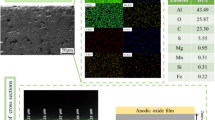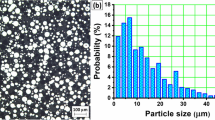Abstract
In this study, the paint layer was removed on the surface of 5083 aluminum alloy using laser cleaning and mechanical grinding. The microstructure and performance of experimental samples were carefully investigated using scanning electron microscope, energy disperse spectroscopy and other methodologies. The results showed that compared with mechanical grinding, laser cleaning can improve the surface paint coating of aluminum alloy more effectively. The surface of the matrix formed uniformly distributed volcanic craters and small holes emerged at the spot junction after laser cleaning. The carbon and oxygen content on the substrate surface after laser cleaning was much lower than that after mechanical grinding. In addition, the corrosion resistance and coating adhesion of the substrate were obviously improved using laser cleaning. It was closely associated with refinement of the grains and reduction in surface roughness. We concluded that laser cleaning can be widely used to replace mechanical grinding in manufacturing on the premise of meeting industrial needs.
Similar content being viewed by others
References
J. Paik, Mechanical properties of friction stir welded aluminum alloys 5083 and 5383, International Journal of Naval Architecture and Ocean Engineering, 1(1) (2009) 39–49.
J. Cheng, Y. Huang and W. Dong, Experimental study on nanosecond laser cleaning of anodic oxide film of 5083 aluminum alloy, Applied Laser, 39(1) (2019) 171–179.
W. Zhang, Technical status and application progress of marine coatings (part one), Marine Equipment Materials and Marketing, 2 (2008) 31–35.
A. Qian, P. Wang and X. Tan, Research on the aging failure of organic coatings and key technical issues, Mechanical Science and Technology for Aerospace Engineering, 36(S1) (2017) 84–90.
B. Tian, W. Zou and Z. He, Pulsed Nd:YAG laser paint removal experiment, Cleaning World, 10 (2007) 1–5.
M. Zhao and J. Jing, Localization and application of coating system for high speed EMUs, Modern Paint and Finishing, 15(9) (2012) 24–27.
Z. Lei, Z. Tian and Y. Chen, Laser cleaning technology in industrial fields, Laser and Optoelectronics Progress, 55(3) (2018) 60–72.
D. Bauerle, Laser processing and chemistry: recent developments, Applied Surface Science, 186(1–4) (2002) 1–6.
G. Daurelio, G. Chita and M. Cinquepalmi, New laser surface treatments: cleaning, derusting, deoiling, depainting, deoxidizing, and degreasing, Proc SPIE, 3097 (1997) 369–391.
L. Zhang and H. Zhou, Application of laser cleaning technology in the protection and restoration of a female painted pottery figurine in han dynasty, Sciences of Conservation and Archaeology, 29(2) (2017) 67–75.
X. Zhang, P. Zhang and C. Yang, Application of laser cleaning technology in the protection and restoration of a gilt bronze cultural relic, Sciences of Conservation and Archaeology, 25(3) (2013) 98–103.
Z. Zhang, X. Yu and Y. Wang, Experimental study about cleaning of tire molds with pulse YAG laser, Laser Technology, 42(1) (2018) 127–130.
G. Zheng, R. Tan and Y. Zheng, Experimental study on TEA CO2 laser paint stripping, Laser Journal, 5 (2005) 82–84.
G. J. Tserevelakis, J. Santiago Pozo-Antonio and P. Siozos, On-line photoacoustic monitoring of laser cleaning on stone: evaluation of cleaning effectiveness and detection of potential damage to the substrate, Journal of Cultural Heritage, 35 (2019) 108–115.
G. Schweizer and L. Werner, Industrial 2 kW TEA CO2 laser for paint stripping of aircraft, Proceedings of Spie the International Society for Optical Engineering, 2502 (1995) 57–62.
Y. Iwahori, T. Hasegawa and K. Nakane, Experimental evaluation for CFRP strength after various paint stripping methods, Aeronautical and Space Sciences Japan, 55 (2007) 235–240.
G. Jiang, P. Lei and Y. Liu, Laser removal of coating on oil and gas pipelines: effects on microstructure and hardness of substrate, Chinese Journal of Lasers, 47(3) (2020) 167–174.
D. Wang, G. Feng and G. Deng, Study of mechanism on laser paint removal based on the morphology and element composition of ejected particle, Chinese Journal of Lasers, 42(10) (2015) 115–121.
R. Tan, G. Zhen and Y. Zhen, The effect of laser paint stripping on the mechanical properties of the substrate, Laser Journal, 6 (2005) 83–84.
Y. Li, Q. Yue and H. Li, Friction and wear characteristics of 20Cr steel substrate and TiAlN coating under different lubrication conditions, International Journal of Precision Engineering and Manufacturing, 19(10) (2018) 1521–1528.
G. Zhu, S. Wang and W. Cheng, Investigation on the surface properties of 5A12 aluminum alloy after Nd: YAG laser cleaning, Coatings, 9(9) (2019) 578.
H. Zhao, Y. Qiao and X. Du, Laser cleaning performance and mechanism in stripping of polyacrylate resin paint, Applied Physics A, 126(5) (2020) 360.
Y. Li and F. Wang, Effect of surface nanocrystallization on electrochemical corrosion behavior of metal materials, Journal of Chinese Society of Corrosion and Protection, 1 (2003) 6–8.
W. Li and D. Y. Li, Influence of surface morphology on corrosion and electronic behavior, Acta Materialia, 54(2) (2006) 445–452.
X. Zhang, J. Chen and S. Liu, Bonding force test of multilayer oxide skin on high strength steel based on scratch test, Materials Protection, 51(4) (2018) 125–129.
M. Furuno, K. Kitajima and Y. Tsukuda, Effect of ground surface roughness of tool on adhesion characteristics of PVD coating, Advanced Materials Research, 325 (2010) 315–320.
Acknowledgments
This work is supported by the National Natural Science Foundation of China (Grant No. 51861165202 and 51705173) and Science and Technology Planning Project of Guangdong Province (Grant No. 2017B090913001).
Author information
Authors and Affiliations
Corresponding author
Additional information
Yunkai Li is currently a master candidate student in Materials Processing Engineering at the Huazhong University of Science and Technology, Hubei, China. His research interests are in the area of paint removal using laser cleaning.
Rights and permissions
About this article
Cite this article
Li, Y., Wang, C. & Mi, G. Influence of cleaning modes on the microstructure and performance of 5083 alloy substrate. J Mech Sci Technol 35, 3943–3949 (2021). https://doi.org/10.1007/s12206-021-0807-6
Received:
Revised:
Accepted:
Published:
Issue Date:
DOI: https://doi.org/10.1007/s12206-021-0807-6




